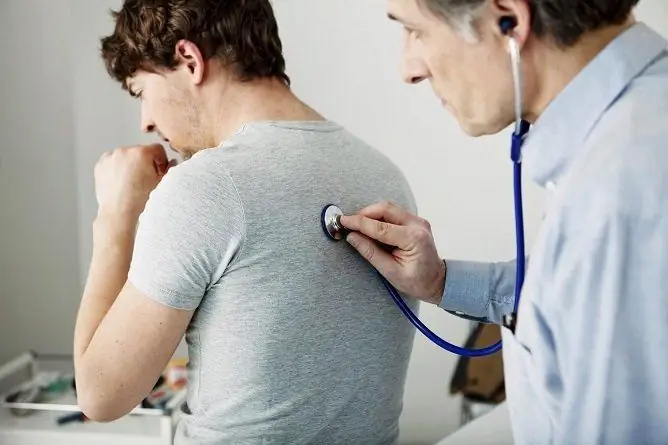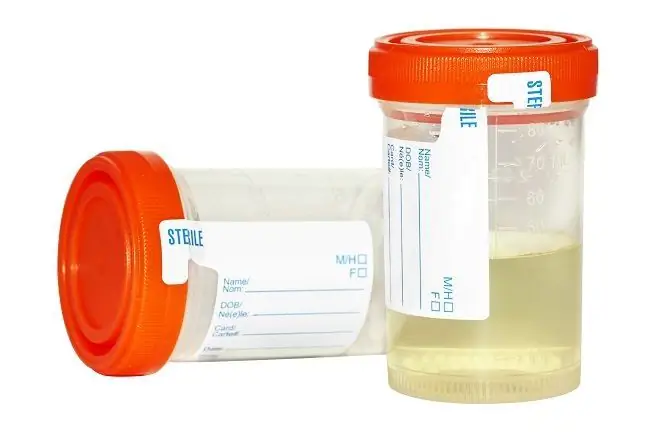- Author Rachel Wainwright [email protected].
- Public 2024-01-15 19:51.
- Last modified 2025-11-02 20:14.
How much pneumonia is treated in adults at home and in hospital
The content of the article:
-
How is pneumonia treated in adults?
Evaluation of the effectiveness of treatment
-
How many days is pneumonia treated in adults at home and in a hospital
Aftercare for pneumonia
- What symptoms may persist after the end of antibiotic therapy
-
Why treatment can take longer than average
- Inadequate response to treatment
- Misdiagnosed
- Features of therapy for elderly and senile patients
- What is important to know to shorten the timing of pneumonia treatment
- Video
How long is pneumonia treated, and what determines the time it takes to fully recover? This is an important question, since for the period of illness it is necessary to issue a sick leave, and the disease itself, in order to avoid the development of complications, must be cured completely.

The time it takes to treat pneumonia is determined by the doctor after evaluating many factors.
Pneumonia is an acute inflammatory process of infectious etiology that develops in the lower respiratory tract. It manifests itself with characteristic symptoms - fever, cough, sputum (possibly purulent), chest pain, shortness of breath, as well as radiological signs of fresh focal infiltrative changes in the lung tissue.
Most often, the development of community-acquired pneumonia is noted, that is, it arises outside the hospital, either in the first 48 hours after hospitalization, or later than four weeks after discharge.
How is pneumonia treated in adults?
For the treatment of pathology, antibiotics are prescribed. Promptly, it is very important to start therapy quickly, preferably not later than 4 hours after diagnosis.

The mainstay of treatment for the inflammatory process in the lungs are antibacterial drugs.
In the case of the development of sepsis, septic condition / shock, it is considered appropriate to reduce this period to 1 hour. At the same time, no studies required to clarify the diagnosis should not cause a delay in the initiation of etiological therapy.
Patients who are hospitalized due to a severe course of pneumonia are advised to prescribe parenteral antibiotics. In the future, it is possible to switch to oral administration of the same drug or an antibiotic that has a similar mechanism of action and spectrum of activity (stepwise antibiotic therapy).
Evaluation of the effectiveness of treatment
After the start of treatment, its effectiveness is evaluated within 2-3 days. The main criteria for the adequacy of antibiotic therapy are:
- body temperature <37.5 ° C;
- blood leukocyte count <10 x 10 9 / l;
- absence of purulent sputum, intoxication, respiratory failure, negative dynamics on the roentgenogram.
How many days is pneumonia treated in adults at home and in hospital
how long adult pneumonia heals depends on many factors. According to the protocol for treating the disease, the average duration of therapy is determined by the severity of the pathology:
| The severity of the course of pneumonia | Average duration of treatment | Treatment conditions |
| Not severe | 14-16 days | Outpatient, day hospital |
| Average severity | 16-18 days | Inpatient: day or round-the-clock hospital |
| Severe, proceeding with complications | 22 days |
< p> Inpatient with 24/7 stay |
| Severe, complicated by abscess, sepsis and septic shock | 28 days | Inpatient stay with 24/7 |
The need for hospitalization of patients with severe pneumonia due to a high risk of complications, including the following diseases:
- acute pulmonary insufficiency;
- acute respiratory distress syndrome;
- pleurisy;
- multiple organ failure;
- septic shock;
- sepsis;
- abscess formation of lung tissue.
Aftercare for pneumonia < / h3>
After suffering mild and moderate pneumonia, dispensary observation lasting from 1 to 6 months on an outpatient basis is indicated. After severe pneumonia, follow-up treatment is required in a day or round-the-clock hospital for 8-10 days.
After the end of antibiotic therapy, therapeutic and prophylactic measures are carried out, including physiotherapy exercises
During this period, a complex of therapeutic and preventive measures is shown:
- breathing exercises, remedial gymnastics;
- massage;
- physiotherapy;
- treatment of concomitant diseases (if necessary);
- symptomatic therapy.
Within 12 months after the illness, spa treatment can be prescribed.
What symptoms may persist after the end of antibiotic therapy
After the end of the course of treatment, individual clinical, radiological or laboratory signs of the disease may persist, however, their presence for the continuation of antibiotic therapy is not an absolute indication.
Conditions and clinical signs that are not grounds for continuing treatment:
| Signs | Description |
| Preservation of persistent subfebrile condition (body temperature in the range of 37.0-37.5 ° C) | If there are no other signs of a bacterial infection, subfebrile condition may indicate non-infectious inflammation, post-infectious asthenia, or be a symptom of drug fever |
| Dry cough | This symptom after a previous illness can persist for 1-2 months, especially in smokers and patients with chronic obstructive pulmonary disease |
| Residual changes on the radiograph | Changes (in the form of infiltration, strengthening of the pulmonary pattern) after an illness can be recorded for 1-2 months |
| Wheezing | Wheezing can last 3-4 weeks or more, they reflect the natural course of the disease (local pneumosclerosis) |
| Sweating, weakness | These symptoms are referred to as manifestations of post-infectious asthenia. |
| Increased ESR | It is considered a non-specific indicator, it is not a sign of a bacterial infection |
Why treatment can take longer than average
In some cases, the disease lasts longer than average, which may be due to many reasons.

Some patients respond inadequately to treatment, which increases the duration of the illness
Inadequate response to treatment
Risk factors for late (inadequate) response to treatment are:
- advanced age (> 65 years);
- irrational empirical antibacterial treatment;
- the presence of chronic concomitant diseases such as chronic heart failure, chronic obstructive pulmonary disease, hepatic / renal failure, malignant neoplasms, diabetes mellitus, etc.;
- extrapulmonary foci of infection;
- identification of highly virulent pathogens (enterobacteria, L. pneumophila), especially in patients with risk factors for infection with antibiotic-resistant strains;
- the presence of cavities of destruction, multilobar infiltration, exudative pleurisy or pleural empyema, bacteremia, leukopenia.
Misdiagnosed
Another reason for the protracted course of pneumonia is an incorrect diagnosis. In case of an inadequate response to the treatment, it is necessary to carry out a differential diagnosis, which requires additional research:
- lung metastases: examination for atypical cells of pleural exudate, biopsy of peripheral lymph nodes, ultrasound of the liver, positron emission tomography;
- lung cancer: examination for atypical sputum cells and pleural exudate, ultrasound of internal organs, biopsy of peripheral lymph nodes, open lung biopsy;
- disseminated lung diseases: study of ventilation and diffusion functions of the lungs, positron emission tomography, diagnostic search for primary localization of cancer, including ultrasound of internal organs, occult blood feces, sigmoidoscopy, consultation with a urologist, gynecologist;
- pulmonary tuberculosis: examination of sputum for acid resistance of mycobacteria according to Ziehl - Nielsen, open lung biopsy;
- fungal lesions of the lungs: sputum and blood culture for fungi, detection of secretory IgA to fungal antigens and mycotoxins in saliva, determination of A. fumigatus galactomannan antigen in blood serum, cerebrospinal fluid, urine, determination of specific antibodies in blood serum.
Features of therapy for elderly and senile patients
Treatment of elderly and senile patients is an important medical and social problem of geriatric practice. In this group of patients, pneumonia is usually treated longer and harder, and a high mortality rate is also recorded.

In older patients, pneumonia is difficult to diagnose and treat
This is primarily due to the difficulty of timely diagnosis and the appointment of adequate treatment, since pneumonia is often associated with various concomitant diseases. In an elderly person, their decompensation often occurs, which greatly complicates the diagnosis, complicates therapy, and generally worsens the prognosis.
What is important to know to shorten the timing of pneumonia treatment
It is believed that pneumonia can be treated with a short course of antibiotics. However, self-medication is not recommended. It should be borne in mind that some pathogens are resistant to the action of many antibacterial agents, therefore, such therapy will be ineffective and will significantly affect the duration of the disease.
It should be borne in mind that pneumonia is a common disease, therefore, when characteristic symptoms appear, it is important to seek medical help in a timely manner.
Video
We offer for viewing a video on the topic of the article.

Anna Kozlova Medical journalist About the author
Education: Rostov State Medical University, specialty "General Medicine".
Found a mistake in the text? Select it and press Ctrl + Enter.






